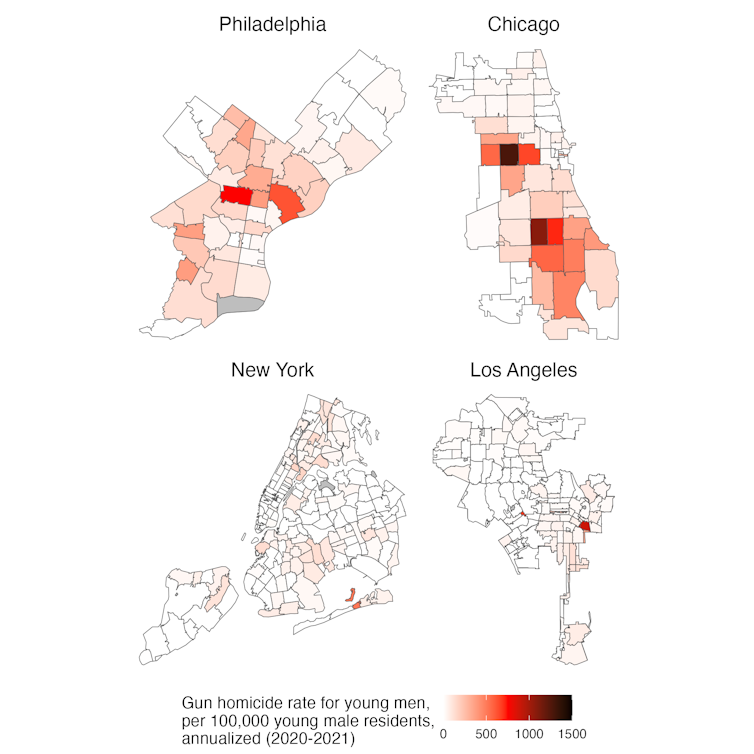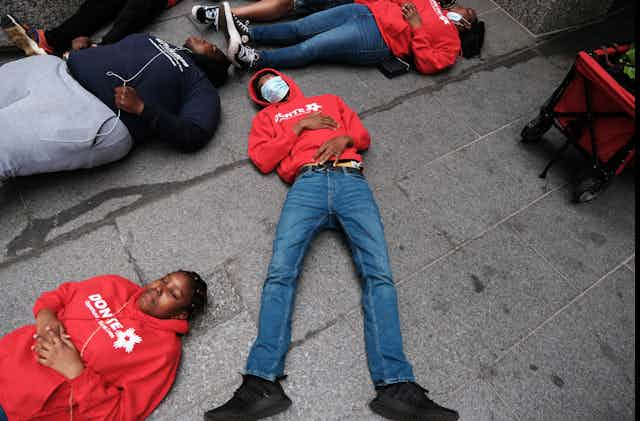Mass shootings tend to dominate the debate over gun violence – but they accounted for just 3% of all firearm homicides in the United States in 2021.
The vast majority of gun homicides are murders that happen in an extremely concentrated number of neighborhoods – places where the rate of gun deaths rivals war zones.
As a scholar of gun violence and victimization in the United States, I study and publish research on the geographic and demographic concentration of shootings, and I’m always searching for new perspectives to help people understand this crisis.
Concentrated disadvantage
Shootings happen over and over in the same locations. About half take place in just 1% to 5% of the land area in U.S. cities – in other words, in a tiny percentage of the nation’s homes, stores, parks and street corners.
These same neighborhoods tend to suffer from what criminologists call concentrated disadvantage – an unsavory mix of high crime rates, illegal drug markets, poverty, limited educational and economic opportunities, and residential instability. Cumulatively, these factors decrease the residents’ ability to maintain public order and safety in the ways that safer neighborhoods do informally by confronting violent behavior or supervising teenagers.
Kids who grow up in these neighborhoods suffer the long-lasting repercussions of exposure to violence, such as high levels of stress and trauma that dampen educational attainment and result in decreased cognitive ability.
The demographics of these neighborhoods means that both victims and perpetrators of shootings are disproportionately young Black men. Young Black men represented 93.9% of firearm-related homicide victims in Chicago and 79.3% of gun homicides in Philadelphia – where young Hispanic men make up another 12.9%. Homicides disproportionately affect the young largely because men ages 15 to 25 are more likely to engage in delinquent and criminal behavior, a phenomenon known as the age-crime curve.
How bad is it? For some young men, it can be safer to be in the U.S. military at war than living at home in the most violent neighborhoods of Philadelphia and Chicago.
How we did this work
This finding comes from a study my co-authors, Brandon Del Pozo and Aaron Chalfin, and I did to compare shooting rates in Philadelphia, Chicago, New York and Los Angeles with casualty rates of U.S. military personnel during the recent campaigns in Iraq and Afghanistan.
Our paper is published in JAMA Network Open, an open-source medical journal, and is freely available to read.
We first collected all publicly available city-level data on shooting deaths, including the time, exact place and information about the victim. Our study focused on Philadelphia, New York, Los Angeles and Chicago because they were the largest American cities with public data available. However, gun homicides happen everywhere, with notable rates of gun homicides in St. Louis, Missouri; Baltimore; New Orleans; Detroit and Cleveland.

In military zones
For the military casualties, we relied on the estimates from studies of the mortality of U.S. soldiers at war in Afghanistan and Iraq.
The Afghan War was deadlier, with 395 deaths of U.S. combatants per 100,000 people per year, compared with 330 in Iraq. We used the higher rate from the Afghan War as our reference, setting its value as 1 and expressing the homicide rate in other places in relationship to this benchmark.
How places compare
The most violent ZIP code in Philadelphia is 19132 in North Philadelphia, which includes parts of Strawberry Mansion and the blocks further north and east. The violence of these city streets was captured by sociologist Elijah Anderson in his ethnographic study “Code of the Street,” published in 2000.
A young man living in this ZIP code had 1.91 times more annual risk of getting killed with a firearm than a U.S. soldier deployed to Afghanistan for a comparable amount of time.
During 2020 and 2021, this ZIP code was home to about 2,500 young men. Thirty-seven were killed in gun homicides.
A similar calculation for the most violent neighborhood of Chicago, an area around Garfield Park with the ZIP code 60624, yields statistics that are even grimmer. Young men living there were 3.23 times more likely to die from a bullet than U.S. service members deployed to Afghanistan. Sixty-six young men were shot dead during 2020 and 2021.
Moreover, survivors of this violence bear the burden of it for the whole time they live in these neighborhoods. In contrast, the average deployment is less than 12 months.
Complicating the narrative
Research papers like ours can raise many “yeah but” questions. Answering them can better help us understand the limitations of our study.
For example, many service members do not engage in active combat. This fact made our research team wonder if the inclusion of data from personnel in safer support roles was skewing our data, so we specifically looked at the casualties of one U.S. brigade combat team that was heavily engaged during the Iraq War.
The brigade had a casualty rate 1.71 times higher than our benchmark. That means that members of the brigade were still safer than male youth in the most violent area of Philadelphia (with a casualty rate of 1.91 times higher) and Chicago (3.23 times higher).
It is also worth noting that we studied two particularly violent years in U.S. cities. 2020 saw a record increase in homicide rates. That number stayed high in 2021, before decreasing slightly in 2022.
Lastly, on a more positive note, gun mortality in New York and Los Angeles was significantly lower than in Philadelphia and Chicago, and much lower than the risks faced in war.
Faster care could help
Our research also showed that soldiers who are injured on the battlefield are less likely to die from their wounds than people shot in the American cities we studied.
Surviving a wound is more likely if medical help is immediate. This suggests two ideas to decrease shooting deaths: train more police officers to provide urgent basic medical treatment to the victims of gun violence and add capacity to trauma centers near violent neighborhoods.

